Top 13 Most Notorious Serial Killers In The World Of All Time
 |
| Top 13 Most Notorious Serial Killers By Number In The World Of All Time. Photo: Knowinsiders |
What defines a serial killer?
A serial killer is someone who commits at least three murders over more than a month with an emotional cooling off period in between, according to the FBI.
According to the NIT (National Institute of Justice), it involves committing two or more murders with a psychological motive and sadistic sexual overtones.
Officially, a serial killer is a person who murders more than three people, although not all at the same time. Law enforcement officers who study and pursue serial killers believe that these kinds of murders are performed for some psychological reason, usually very deliberately and with "down time" between each killing. The word serial, or "one in a series," has been used to talk about murder since the 1960s, though the term serial killer was first used in 1981.
The Short List of Top 13 of The Most Notorious Serial Killers In The World of All Time
| 1. THUG BEHRAM Kill 931 people 2. ELIZABETH BATHORY Kill 650 people |
| 3. GILLES DE RAIS Kill 600 people |
| 4. PETER NIERS Kill 544 people |
| 5. AMELIA DYER Kill 400 people |
| 6. PEDRO LOPEZ Kill 350 people 7. LUIS GARAVITO: The Beast Kill 140 to Over 300 boys |
| 8. JOHN JOHNSON Kill 300 people 9.HAROLD SHIPMAN “Dr. Death Kill 218 people |
| 10. HERMAN MUDGETT Kill 200 people |
| 11. DANIEL CAMARGO Kill 150 people |
| 12. LUIS GARAVITO Kill 140 people |
| 13. JACK THE RIPPER Kill Around 100 people |
| Serial killing is the rarest form of homicide, occurring when an individual has killed three or more people who were previously unknown to him or her, with a ‘cooling off’ period between each murder. This definition is accepted by both police and academic experts and therefore provides a useful frame of reference. |
Top 13 of The Most Notorious Serial Killers By Number In History - Detail
1. THUG BEHRAM - KING OF THE THUGS
Thug Behram was one of the most prolific serial killers of the 18th century in Indian History. He is called the most prolific serial killer in the world. He was a leader of the Thuggee cult.
The most notorious among them was their leader, Thug Behram- The King Of Thugs. One of the most prolific in the history of mankind, he was responsible for murders of an estimated 931 people, according to India Media.
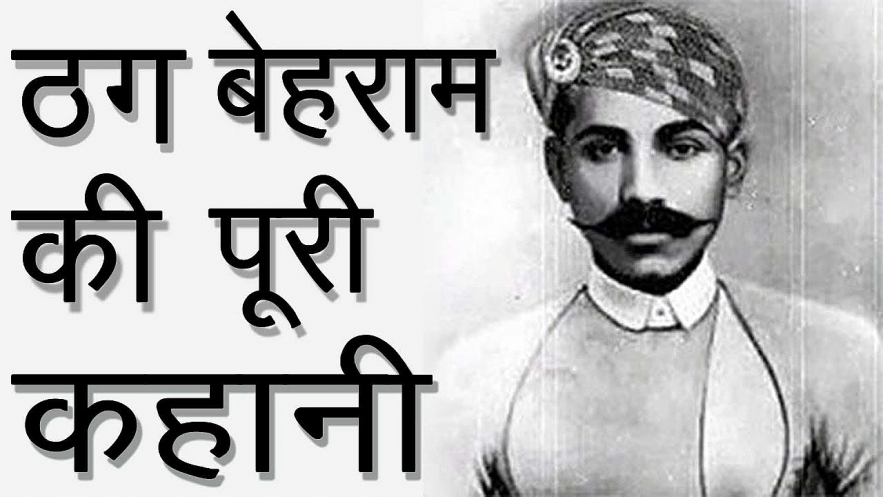 |
| Thug Behram, leader of the Indian Thuggee cult |
Nation, Born: India
Died:1840 in Jabalpur, British-owned India
Profession: Leader of the Thuggee cult
Span of killings: 1790 – 1840
Location of killings: North-Central India
Modus operandi: Alongside his cult followers (“Thuggees”) he ambushed and robbed travelers and merchants, then strangled them to death in a ceremonial ritual
Arrest and Punishment: Arrested in 1840 by British officers and hanged to death in the same year.
2. ELIZABETH BATHORY - THE BLOOD COUNTESS
Who is Elizabeth Bathory - Biography
Bathory was born on August 7th, 1560, in Nyirbator, into the noble family of the Bathory’s estate. Bathory’s parents were blood relatives, and her father was Baron George VI Bathory. Her father was brothers with the highest-ranking official within Hungary’s kingdom, the Voivode of Transylvania, Andrew Bonaventure Bathory. Bathory’s mother, Anna Bathory, was also a noble.
Bathory’s uncle was the King of Poland. She was also related to the Grand Duke of Lithuania and the Prince of Transylvania. Also, Bathory’s brother, Stephen Bathory, was the judge royal of Hungary. Therefore, Bathory grew up in an extremely wealthy family. She had the privilege of the best education and enjoyed social power. However, she frequently suffered from intense seizures caused by epilepsy.
Bathory’s parents raised her in a very religious household. She had the opportunity to learn Latin, German, Hungarian, and Greek in school. She got engaged to Ferenc Nadasy — son of Baron Tamas Nadasdy and Orsolya Kanizsay — at ten years old for political purposes.
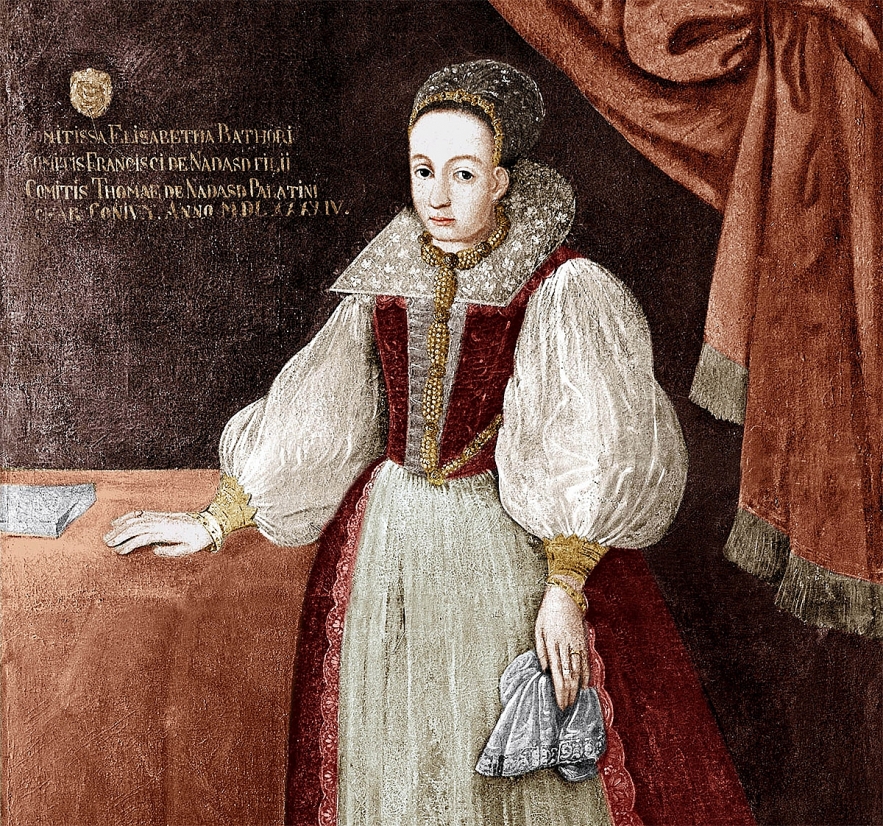 |
| Death of Countess Elizabeth Bathory |
Elizabeth married her husband, Count Ferenc Nadasdy, in 1575, at the age of fifteen, and moved to Castle Cachtice. The Castle Cachtice was a wedding gift to Bathory from Nadasdy. There were over 4500 guests at their wedding. It is important to note that she retained her family name after the marriage because of its higher social hierarchy. Also, Nadasdy had ordered his workers to build a custom torture chamber for Bathory to use for her victims.
The couple had four children, Paul, Anna, Ursula, and Katherine. Later on, Nadasdy became the chief commander of the Hungarian troops in the war against the Ottomans. This landed Elizabeth the role of commander, giving her the power to handle administrative issues.
| Died: August 21, 1614 in Csejthe, Kingdom of Hungary (modern-day Cachtice, Slovakia) Profession: Countess of the noble Bathory Family Span of killings: 1590 – 1610 Location of killings: The Cachtice Castle in modern-day Cachtice, Slovakia |
Crimes
Tortured and killed young women and girls (usually orphans, widows and peasant women).
While her husband was away for work, Bathory would bring lovers to the castle. The countess would also torture her victims in the torture chamber, and on some occasions, her husband would help her. Nadasdy died on January 4th, 1604, from an illness that ailed him for three years before his death.
After the death of her husband, Bathory got out of control. She became ruthless in the way she tortured and killed her victims, and the methods she used highly depended on her mood. Her victims were usually girls between the age of ten and fourteen.
In the beginning, her target victims were young peasant girls who were rarely sought after when they went missing. She later shifted her focus to the daughters of the higher branches of society. The girls were often sent to Bathory’s quarters by their parents to learn good etiquette.
Historians viewed her crimes as sexually motivated. However, Bathory committed her crimes for other motives. After killing a victim, she drained the victim’s blood, poured it into a cup, and drank it. She believed that the blood kept her young and beautiful and also helped in curing her epilepsy.
She killed over 650 women between 1585 and 1609. In 1610, she began abducting the daughters of local nobles. When the nobles came together to discuss their daughters’ disappearance, they traced everything back to Bathory.
Punishment and Death: Arrested in 1610 and sentenced to life imprisonment (died in prison four years later).
On December 10th, 1610, Count Gyorgy Thurzo, responsible for handling judicial matters in Hungary, was investigating the allegations when he walked in on Bathory torturing a young girl. The horrible event led to Bathory’s arrest and that of everyone else who was involved in committing the crimes. Some of her accomplices were sentenced to death.
Multiple witnesses and servants confessed against Bathory, and officials went through her private journal, which indicated that she had killed around 650 girls. Elizabeth Bathory lived in isolation in a room with no windows in her castle until her death, on August 21st, 1614, at the age of fifty-four from a cold.
 Top Zodiac Signs Most Likely To Be Killers, Criminals Top Zodiac Signs Most Likely To Be Killers, Criminals Check out the Top Zodiac Signs Likely To Be A Serial Killer or Criminals - The List Most Dangerous Zodiac Signs. |
3. GILLES DE RAIS - MARSHAL OF FRANCE
Who is Gilles de Rais - Biography
Gilles de Rais was born in 1404 and grew up in a wealthy family in northern France. At the age of eleven, he inherited an enormous amount of wealth, and his fortunes drastically increased when he married into another rich family.
Given the title Baron and Lord, Rais was described as a handsome man, who was well-mannered and charismatic.
Furthermore, he became a soldier around the age of sixteen and participated in the Hundred Years’ War as a leader in the French military.Later on, the king of France, King Charles VII, gave Rais the prestigious title of Marshal of France. During his time in the French military, he fought alongside the young Joan of Arc, and Rais became her chief lieutenant in the process. Being a devout Christian, Rais’ respect and admiration for Joan was immeasurable. He grew to love her, not romantically, but rather on a spiritual level.Having had such an unprecedented reputation up to this point, how does a nobleman like Gilles de Rais stoop to become a sadistic serial killer?
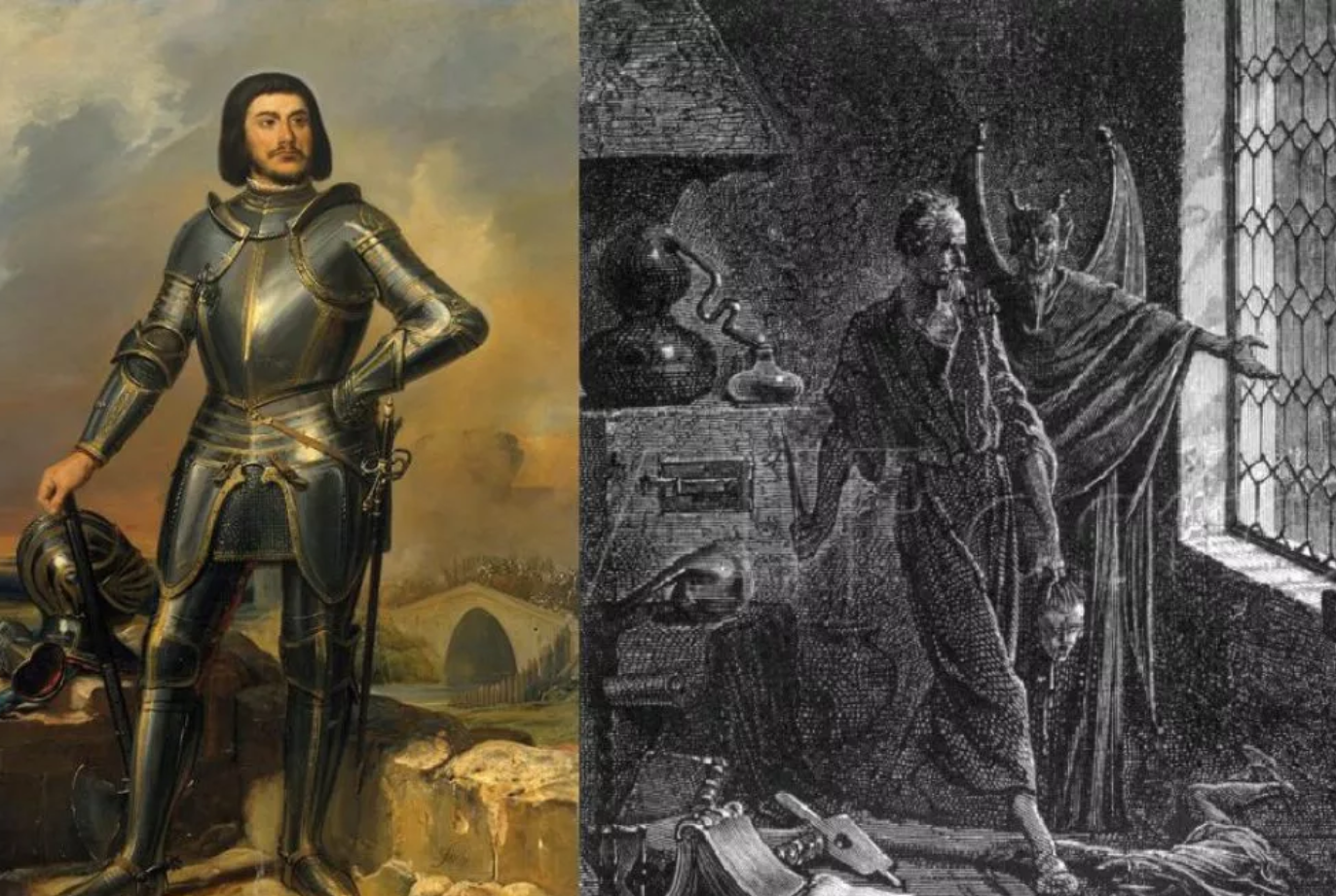 |
| Lord Gilles de Rais: Marshal of France (Left); Gilles de Rais: The devil's servant (Right) |
| Died: October 26, 1440 in Nantes, Duchy of Brittany, Kingdom of France Span of killings: 1432 – 1440 Location of killings: Throughout northwestern France (especially in Anjou & Brittany) |
Murders and Punishment
In 1435, now bankrupt and no longer involved with the military, Rais began selling his properties to support his extravagant lifestyle. On July 2, a royal edict denounced Rais and prohibited him from selling any further property, Rais subsequently left Orléans.
Rais' first murders occured between 1431 and 1433, with the help of his accomplices, Rais kidnapped and killed an unknown number of children, some were even used rituals involving alchemy and demon summoning. On one occasion, Rais provided a contract with a demonic entity named Barron and attempted to summon him, but grew frustrated after no demon manifested.
Having being told that Barron demanded the soul of at least one child, Rais murdered a boy and dismembered him, placing his limbs inside a glass vessel, but again, no demon manifested. On May 15, 1440, Rais abducted and murdered a cleric, which caught the attention of the Bishop of Nantes, who investigated him and discovered his heinous crimes, 40 bodies of his victims were found.
Rais was arrested on September 15 and subsequently confessed to the murders and was sentenced to death along with his accomplices. Rais was hanged and burned on October 26, 1440, at the age of 36.
Modus Operandi
Rais targeted males and females between the ages of 6 and 18, but he was more interested in murdering boys for an unspecified reason.
They would be abducted by Rais' accomplices and taken to a secluded place, where Rais would strip them naked. He then hung them with ropes from a hook; and tortured, molested, and raped them. Rais would often tell the children that he only wanted to "play" with them. After being satisfied, Rais would order his accomplices to kill them or do it himself.
His victims were killed in a variety of ways, mostly with a short double-edged sword called a braquemard, which was used to slash their throats, decapitate them, or dismember them. Rais would often sit on their stomachs as they were dying. After killing his victims, he would kiss them and mutilate their bodies to admire their limbs and organs. Sometimes, Rais would even have sex with his victims' mangled bodies. In order to dispose of their bodies, they would be cremated or buried.
4. PETER NIERS
Who is Peter Niers - Biography
Peter Niers raped and killed over 544 people which also included 24 fetuses(unborn child) which he cut out from pregnant women.
Niers was born into a peasant family in 16th-century Germany. During the heyday of serfdom, Niers saw firsthand the struggles of rampant classism. No doubt the inhumane living conditions and treatment of the peasant class were a catalyst for his later sociopathy.
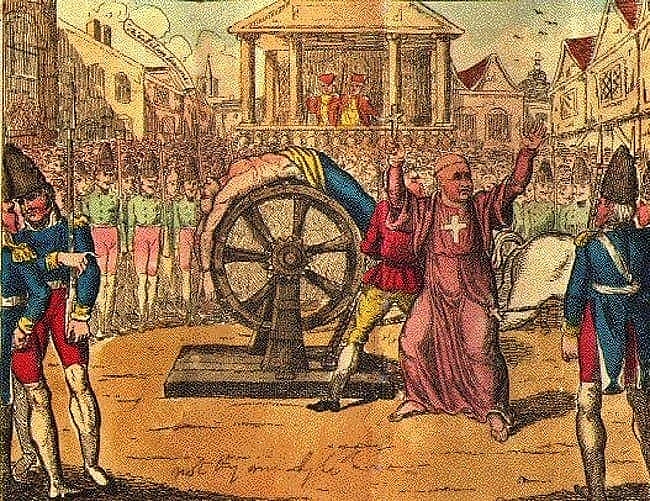 |
| The execution of Peter Niers |
| Died: September 16, 1581 in Neumarkt in der Oberpfalz, Electoral Palatinate, Holy Roman Empire Span of killings: 1566 – 1581 Location of killings: His criminal activities spanned a large territory that included western France, the Rhineland, and Bavaria in southern Germany. Modus operandi: Robbed and murdered his victims, at times cannibalism (ate the fetuses of pregnant female victims) |
Crimes
Over a 15 year period, as he confessed after his arrest, Niers murdered 544 people, and cut the fetuses out of the wombs of 24 pregnant women. The fetuses were used as ingredients in his black magic, and consumed in cannibalistic acts. Niers began his criminal career as a highwayman in Alsace, present day France, and eventually came to head a gang that numbered about 24 bandits. He also became a leading figure in a loose network of bandit and highwayman gangs, that joined forces on occasion to conduct major operations requiring large numbers of men.
Arrest and Punishment
Arrested on September 13, 1581 and quartered alive on the breaking wheel three days later.
What set Niers apart from other bandits was his bloodthirstiness and gratuitous cruelty. He was not content to simply rob or kill his victims. Niers also relished torturing those who fell into his hands, and murdering them in a variety of fiendishly inventive ways. He was captured in 1577, and under torture, confessed to 75 murders during the previous 11 years. However, before he could be executed, he managed to escape.
Niers returned to his criminal activities, resuming them with even greater cruelty and bloodthirstiness. Indeed the majority of his murders and depravities would occur in the following four years: whereas he had murdered 75 years in the 11 years preceding his arrest in 1577, he would murder an additional 569 people in the 4 years from 1577 to 1581, when he was arrested for a second, and final time.
5. AMELIA DYER -BABY KILLER
Amelia Dyer was one of the most prolific murderers in Victorian Britain. She made a living as a “baby farmer”, or someone paid to care for unwanted or abandoned infants – except she killed around 400 of them. Trained as a nurse and widowed in 1869, Dyer turned to baby farming—the practice of adopting unwanted infants in exchange for money—to support herself.
Born in 1829 and raised in Bristol to respectable parents and trained as a nurse before deciding that 'adopting' illegitimate infants was a more lucrative career.
In 1879 she was sentenced to six months' hard labour after being found guilty on a charge of neglect. A doctor had become suspicious of the number of infants who had died while in Mrs Dyer's care and had reported the matter to the authorities. On her release she spent several periods in mental institutions before resuming her child-care activities.
In 1895 she moved to Kensington Road, Reading and began advertising. It was not long before small bodies were being fished out of the Thames. One of the bodies recovered had a tape around its neck and was wrapped in a parcel. The paper enclosing the corpse had an address on it and this was traced to Mrs Dyer. The tiny corpse was identified as Helena Fry.
Dyer was eventually arrested on 4th April 1896. By May, seven tiny bodies had been recovered from the Thames, all had the tape around their necks and all were parcelled. Three of the bodies were identified as four-month-old Doris Marmon, thirteen-month-old Harry Simmonds and the daughter of Elizabeth Goulding. The others were to remain unidentified. She soon confessed, saying "You'll know all mine by the tape around their necks." While in Reading police station she made two attempts to commit suicide.
She came to trial at the Old Bailey in May 1896 charged with just the murder of Doris Marmon, to which she pleaded guilty. The defence tried to prove insanity but failed, despite her dubious mental history. The jury took five minutes to find Dyer guilty and she was sentenced to death. James Billington hanged her at Newgate on 10th June 1896. Police suspected that at least 20 other children had disappeared in a similar manner in the few months before her arrest.
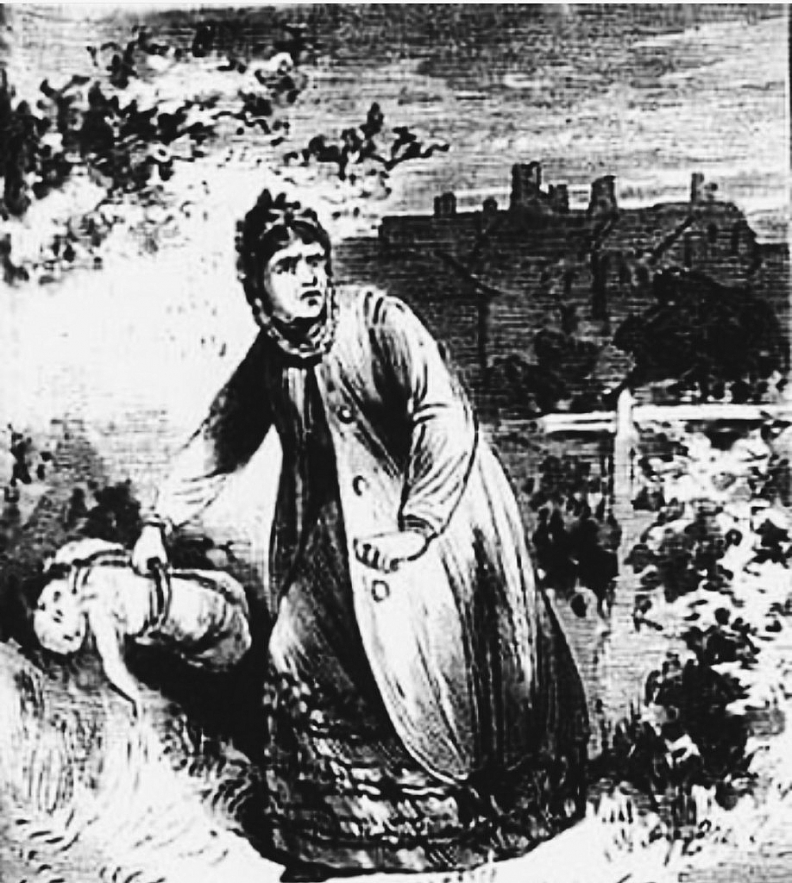 |
| Amelia Dyer - Baby Killer |
Murders
Amelia was apparently keen to make money from baby farming, and alongside taking in expectant women, she would advertise to nurse and adopt a baby, in return for a substantial one-off payment and adequate clothing for the child. In her advertisements and meetings with clients, she assured them that she was respectable, married, and that she would provide a safe and loving home for the child.
At some point in her baby farming career, Amelia was prepared to forego the expense and inconvenience of letting the children die through neglect and starvation; soon after the receipt of each child, she murdered them, thus allowing her to pocket most or all of the entire fee.
For some time, Dyer eluded the resulting interest of police. She was eventually caught in 1879 after a doctor was suspicious about the number of child deaths he had been called to certify in Dyer's care. However, instead of being convicted of murder or manslaughter, she was sentenced to six months' hard labour for neglect. The experience allegedly almost destroyed her mentally, though others have expressed incredulity a
| Born, Nationality: 1836 in Bristol, England, UK Died: June 10, 1896 in London, England, UK Profession: Nurse & baby farmer Span of killings: 1880 – 1896 Location of killings: Bristol, England & later in Reading, England Modus operandi: Murdered the orphaned and unwanted children she previously adopted for financial reasons Punishment: Arrested in April 1896 and hanged to death around two months later |
6. PEDRO LOPEZ - The Monster Of The Andes
Who is Pedro López - Biography
Pedro Alonso López, a.k.a. "The Monster of the Andes", is a prolific Colombian pedophilic and ephebophilic and serial killer, serial rapist, stalker, and abductor believed to have murdered over 300 young girls in Colombia, Ecuador, and Peru. He is considered by many to be one of the world's most prolific serial killers and rapists. To this day, he is presumed to be at large.
Pedro López Childhood
López's mother, Benilda López de Castañeda, was a prostitute. His father, Midardo Reyes, who was married to another woman at the time, was having an affair with Castañeda. López was the seventh of thirteen children. Reyes was shot and killed six months before López was born when a rebellious mob attacked the grocery store he was in. This attack occurred at the beginning of the civil war in Colombia known as La Violencia[1]. López's mother claimed to be loving and caring, but López said that she was cruel and abusive as she raised him. López also claimed that, from a young age, he would watch his mother have sex with clients, and that she would let them hit her on occasion.
When he was eight years old, Castañeda caught López molesting his younger sister, resulting in him being kicked out of the house. Days later, he was found by a pedophile, who lured him with the promise of a hot meal and a bed. Instead, the man took him to an abandoned house and repeatedly sodomized him. After the incident, he joined a gang of street children for protection. The gang would often fight others with knives and belts, for food and places to sleep in. They would also smoke bazuco, a type of drug derived from cocaine. After spending four years surviving on the streets, López was taken in by an American family and became a student in a school for orphans, but he ran away after he was molested by a teacher.
 |
| Pedro López, The Monster of the Andes and his Victims |
| Pedro Lopez - “Monster of the Andes” Killed around 350 people (all underage girls) Born: October 8, 1948 in Santa Isabel, Tolima, Colombia (possibly still alive) Nationality: Colombian Profession: None (occasional car thief) Span of killings: 1969 – 2002 (possibly ongoing) Location of killings: Andes region of Colombia, Peru and Ecuador Modus operandi: Raped and murdered underage girls Punishment: Arrested in 1978 in Peru but released without charge, arrested in 1980 in Ecuador and sentenced to prison until 1994, then deported to Colombia, where he was declared insane and admitted to a psychiatric hospital in Bogota, Colombia. Released from there in 1998. In 2002, he is suspected to have murdered another girl and is currently wanted by Interpol. His whereabouts remain unknown, however. |
Murders, Arrest, and Release
As a young adult, López began to steal cars and sell them to local chop-shops in exchange for sums of money. López was arrested in 1969 for the auto thefts and sentenced to seven years in prison in Bogota. Two days into his sentence, he was brutally gang-raped by three other inmates, an event that deeply traumatized him. Following this, López made a shiv for himself and hunted down his rapists, killing all of them (some versions claim that he was also raped by a fourth inmate, who escaped his wrath; and also that he strangled the ringleader of the rapist with his bare hands). The killings gained him the grudging respect of the other inmates, who never dared to disturb him again, and were considered acts of self-defense by the local Colombian justice department. Because of this, only two years were added to his previous sentence.
Following his release in 1978, López became a drifter and began abducting, raping, and murdering an average of three young girls per week. On one occasion, in Peru, López attempted to abduct a nine-year-old child from an Indian tribe, but he was caught in the act. As a result, López was beaten, tortured, and buried up to his neck by the natives, who planned to pour syrup on his head and let him be eaten alive by ants. However, he was saved when an American missionary intervened and convinced them to let her deliver him to police. The tribe reluctantly agreed, but the unaware missionary instead drove López to the Colombian border, where she set him free. Afterwards, he began traveling through the countries of Colombia and Ecuador, abducting and murdering more girls along the way. Police initially believed that slavery and prostitution rings were abducting the missing children.
Following a flash flood near Ambato, Ecuador, in 1979, the bodies of four of the missing children were uncovered and found. Days later, López attempted to abduct twelve-year-old María Poveda from a marketplace, also in Ambato, but failed when her mother caught him in the act with the help of other women; he was almost lynched on the spot. López was rescued by police officers and arrested while proclaiming that he was a "good person" and that he had "a clean heart". While in detention, López was subjected to a standard interrogation until he told the policemen that he was not Ecuadorian, but a Colombian drifter. A police lieutenant then beat him and accused him of being part of a gang abducting girls from Ambato. The officer threatened to kill him if he didn't confess, but López remained silent.
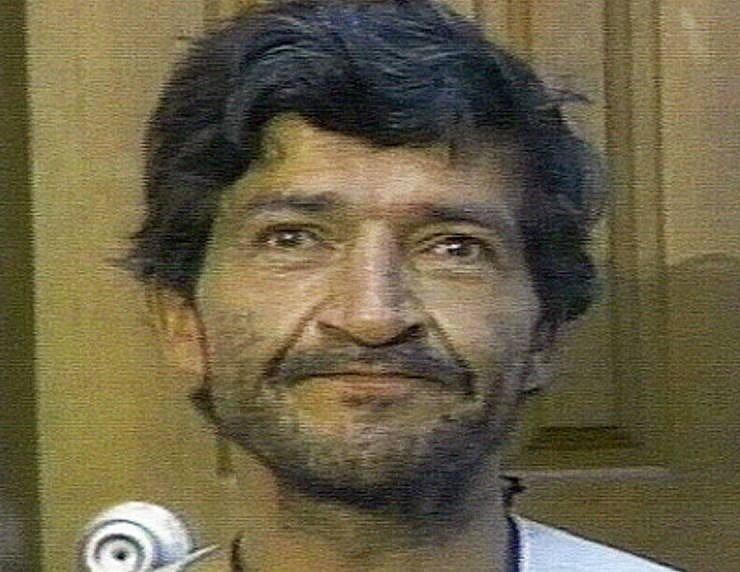 |
| Pedro López - One Of The Most Prolific Serial Killers In History |
In that moment, the officer's superior, Captain Pastor Córdova, entered the room and told all of the policemen to leave, deciding to interrogate the suspect himself with a more friendly approach. He offered López food and cigarettes and asked him about his health and feelings before requesting information about the gang of abductors. López shrugged and said that he knew nothing about that. When the Captain told him that he was under great pressure from the families of the missing girls to find whoever abducted them, López told him that he could find one victim in a cabin outside the town. The police went to the cabin and found a nude, dead body lying on an old mattress, who was identified as Ivanova Jácome, a missing girl. After Córdova asked López how many girls he had killed, López looked upwards and said, "Over two hundred in Ecuador, some tens in Peru, and many more in Colombia." The President was informed and he ordered that López should be taken to the places where he had left the bodies, until all of the victims in Ecuador were recovered.
López led police to more than 30 shallow graves, but after learning that he was going to be charged for murder, he stopped cooperating and declared his innocence. A total of 53 bodies were recovered in Ambato alone, even though many graves had been emptied by flash floods or scavenging animals before the investigators could find them. López's minimum body count is estimated to be at 110, but some believe that the total number is in the vicinity of 300 or more. Many police officers and reporters have disagreed with the latter estimate, saying that it was still very low, because he had stopped cooperating with the investigation. López was convicted of three murders in 1980 and sentenced to sixteen years in prison, the maximum penalty for murder under Ecuadorian law. He was incarcerated in the Pavillion B section of Quito's García Moreno prison, where he was a model prisoner and met a later Colombian pedophilic serial killer, Daniel Camargo.
On August 31, 1994, López was released from prison on good behavior, but an hour later, he was arrested as an illegal immigrant and deported to Colombia. López attempted to stop his deportation, claiming that he had gained Ecuadorian citizenship in 1974, but he could not produce any evidence of this. In Bogota, López protested as he was subjected to a medical evaluation, demanding to be set free even though an angry mob had gathered outside with the intention of lynching him. However, nobody had ever charged López for murder in Colombia. Still reluctant to set him free, the authorities moved López to El Espinal, where he had resided decades earlier with his mother, in hopes that one of his older victims would come forward. A local woman named Alba Sánchez claimed then that in 1979, she had seen López walk away with her daughter Floralba from her home before Floralba's body was found raped and strangled outside town. This M.O. was identical to López's known murders in Ecuador. López was found guilty after a short trial, but his defense attorney demanded that he should be subjected to a psychiatric evaluation first. He was ruled insane in 1995, and as a result, he was committed to a mental hospital instead of being sent to prison. In 1998, a new evaluation deemed him sane, and he was released on $50 bail and the condition that he should continue receiving psychiatric treatment and reporting himself to police every month. However, he did neither.
The news of López's release caused hysteria in Ecuador. It was rumored that he had been seen in the northern part of the country around this time, but this was never confirmed. López was seen next again in El Espinal, when he knocked on the door of his own mother, Benilda. The impoverished woman admitted that she thought he was going to kill her because he had blamed her "for every pain in [his] heart" in a televised interview years earlier, and she had pleaded in turn for López to never be released. However, López calmly told her to get on her knees because he wanted to give her his blessing. Afterwards, he demanded his "inheritance in life", arguing that he had no means to sustain himself. His mother gave him a few bills that she kept in a drawer and an old bed that López took apart to sell for pieces. She never saw him again and his current whereabouts are unknown. In 2002, the Colombian police launched an Interpol order of arrest against López for a new murder in El Espinal that fit the M.O. of his early crimes. Different rumors claim that he is living in Tolima Department, Colombia; as a homeless man in Bogota; or even that he was murdered after some relatives of his victims put a bounty on his head.
He is presumably still at large, although whether or not he has or will start killing again, or his current whereabouts, are unknown.
Modus Operandi
López targeted young girls aged between eight and twelve, mostly from poor, rural Amerindian communities. He had no racial preference and he admitted to having been tempted at times to abduct Caucasian girls, including foreign tourists, but he refrained from doing so because they were more closely watched by their parents. He would stalk the girls for an unknown amount of time and then abduct them. He would bring them to a secluded place, where he would rape them and then strangle them to death. Afterwards, he would bury their bodies in shallow graves, in groups of three or four. Before they decomposed too much, he would return and play "tea parties" with a group of corpses. López only killed in daytime because he wanted to have a clear view of his victims' faces as they died. When he killed the inmates who raped him, he did so by shanking them.
| López was diagnosed as a sociopath with avoidant personality disorder, but not as a true psychopath. Growing up while watching his mother have sex made him assimilate sex with affection, and being thrown out as a result of displaying that affection with his sister made him conclude that affection was something to be punished. His subsequent childhood abuse and deprivations made him assume that destroying childhood innocence was both natural and desirable, and that by killing his victims (chosen because of their perceived innocence more than their looks), he was sparing them from a life of poverty and further abuse. |
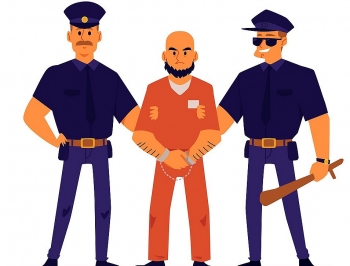 Top 4 Zodiac Signs Born Are Police Officers Top 4 Zodiac Signs Born Are Police Officers Based on each zodiac signs, you can find out what are some of the best jobs. Here are the top 4 zodiac signs born to ... |
7. LUIS GARAVITO - THE BEAST
Who is Luis Garavito - Biography
Luis Alfredo Garavito Cubillos is an Infamous Colombian Man, Called ‘The Beast’, is the Worst Serial Killer in History Because of this Brutal Reason.
Officially, he murdered somewhere between 138 and 192 young boys, but it is possible that he killed 300-400. Despite the horrific nature of his crimes, the Colombian justice system’s maximum penalty of 30 years led to the possibility that Garavito could be released.
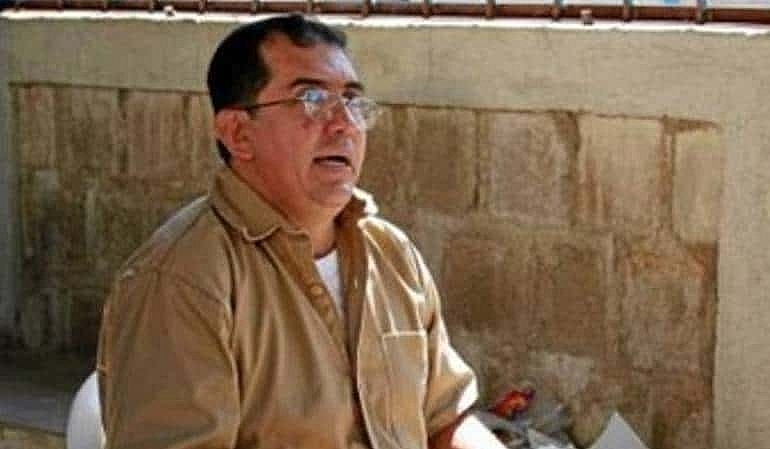 |
| Luis Garavito in Prison |
Childhood & Beginning of his Murder
Luis Garavito was born in Genova, QuindÃo, Colombia on January 25, 1957. He was the oldest of seven brothers, and all of them had a terrible childhood due to the sickening actions of their alcoholic father. Garavito was subjected to physical and sexual abuse from a young age; at least this is what he claimed in interviews after he had been caught.
At the age of 16, Garavito ran away from home to try and start a new life away from his abusive father. To find work, he had to travel all over Colombia. He began by working as a store clerk before he took to the streets to become a vendor who sold prayer cards and religious icons. Despite his constant traveling, Garavito had a girlfriend who also had a small child. By all accounts, Garavito treated the young child well, and his friends described him as a kind man but did note his volcanic temper.
He picked up his father’s alcoholic tendencies and was known to drink heavily and behave belligerently in every location until he wore out his welcome and went elsewhere. According to police reports, Garavito once attempted suicide and spent five years under psychiatric care.
Tactics of Murders
Garavito used these tactics hundreds of times until he was finally arrested in 1999.
It seems as if Garavito began his grotesque murder spree sometime in 1992. He was extremely careful in terms of who he picked as a victim. Practically all of his victims were boys aged 6-16 who were orphaned, peasants or homeless. He knew that these children were vulnerable and no one would report them missing. In most instances, Garavito would approach the boys and lure them away with small gifts or money. While he was careful in some cases by approaching them in the countryside, there were other occasions where he blatantly came up to them in crowded streets.
Garavito would also pretend to offer work to the boys and sometimes, he disguised himself as a ‘character’ to gain the trust of his victims. For example, Garavito dressed up as a priest, elderly man, drug dealer, or a farmer. To avoid suspicion, he changed his character regularly. Once he had the trust of the boys, they would set off on long walks until the children got tired. At that stage, they were easier to deal with.
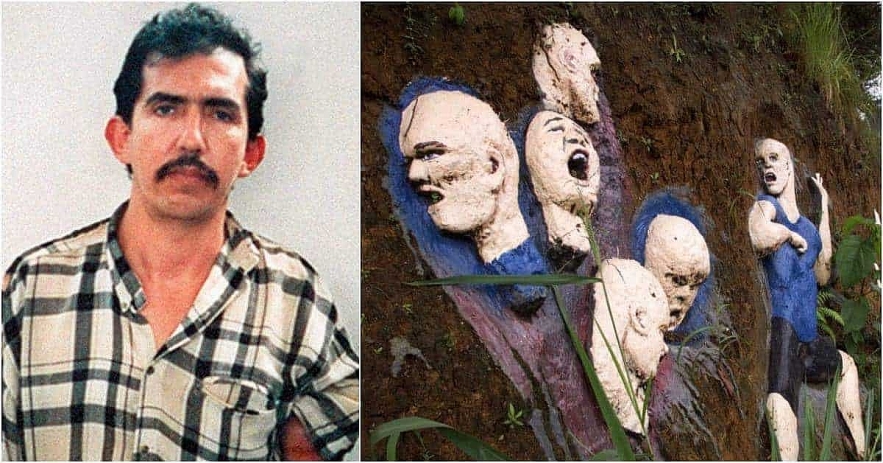 |
| Luis Alfredo Garavito Cubillos - the Worst Serial Killer in History Because of this Brutal Reason |
Between 1992 and 1999, Luis Garavito preyed on innocent young boys throughout Colombia without fear of capture. When he was finally arrested, he admitted murdering boys in as many as 54 towns across the country.
Once Garavito tired out his victims, he would tie them up before torturing and raping them. In some cases, he would cut off their genitals and stuff them in the victims’ mouths. Garavito also decapitated numerous boys. The bodies were usually discovered in shallow graves with several bite marks on them, and the crime scene was surrounded by bottles of liquor and lubricant. After his arrest, Garavito claimed that he was drunk when he killed the children and that his body had been taken over by a ‘superior being.’
Arrest and Punishment: Release in 2021?
Garavito was finally arrested on April 22, 1999, but his captors were initially unaware of his deeds.
Garavito confessed to the murders of 140 children in Colombia and was charged with 172 counts of homicide. He was found guilty of 138 counts, and while his sentence should have been over 1,853 years in prison, Colombian law had a maximum prison sentence of 40 years (according to Article 37.1 of the Colombian Penal Code). Since he also cooperated with the police and showed them the location of some of the bodies, his sentence was reduced to 22 years.
This ludicrous state of affairs meant the specter of early release loomed large as Garavito is scheduled for release in 2021. Fortunately, it seems as if he will remain in prison for life because Colombian law also states that people who commit crimes against children don’t receive ‘any benefit with justice.’ Therefore, he will probably spend between 60 and 80 years in prison.
| Luis Garavito is in a Colombian prison The exact number of Garavito’s victims will never be known, but it could be as high as 400 according to some estimates. At the time of writing, at least 27 of his victims can’t be identified. He also lived in Ecuador at some point in his life and has been linked to the murders of young boys there. Today, Luis Garavito is in a Colombian prison, but the location of the facility has been kept from the public. As he cooperated with the police, he reached an arrangement with them whereby he is kept isolated from other prisoners for his safety. He is extremely paranoid and is terrified of being poisoned, so he only accepts food and drinks from people he trusts implicitly. Hopefully, Garavito remains behind bars forever. |
8. JOHN JOHNSON - LIVER EATING
Who is John Johnson - Biography
John “Liver-Eating” Johnson is known in history as a sailor, mountain man, Indian fighter, and lawman who earned the moniker of “Liver-Eating” because he allegedly killed a number of Crow Indians and ate their livers.
His real name was John Garrison Johnston. Liver-Eating Johnson was born in 1824 in Little York, New Jersey, though he didn’t live there long. At the dawn of the Mexican-American war, he left home to enlist in the Navy.
However, his stint as a sailor didn’t last long either. He then traveled to Montana where he worked as a trapper, miner, wagon master, scout, tour guide, whiskey peddler, and supplier of cordwood to passing steamboats. He also served with the Union during the Civil War.
After striking an officer, whether on purpose or by accident, he fled the army and became a deserter. To throw the authorities off his scent, he changed his name to John Johnson (dropping the ‘t’) and moved out west, away from his roots and from anyone who would be looking for him.
He was about six feet tall and weighed 260 pounds with hardly any body fat. He put his considerable size and strength to work as a “woodhawk” supplying wood for steamboats to shipbuilders.
Murders
Johnston is purported to have married a Flathead woman named the Swan, who was said to have been killed by the Crow. While he was out one day, a group of Crow Indian men attacked his home, killing his wife and burning his house to the ground. Blinded by rage, Johnson vowed to track down and kill each member of the Crow tribe in revenge.
 |
| John Jeremiah Garrison Johnston, nicknamed Liver-Eating Johnson. |
Called Liver-Eating Johnson
Being as well equipped as he was, hunting and killing the Crow was easy for Liver-Eating Johnson, not to mention the root of his nickname. Not only did he hunt and kill the Crow, but he cut out each of the men’s livers and ate them.
The liver is especially important to the Crow people, as they believed it to be necessary to enter the afterlife. By taking the livers out and eating them, Liver-Eating Johnson wasn’t only viciously ending the Crow’s lives, but their perceived chance at the afterlife as well.
In all, legend has it that Johnson killed, scalped, and devoured the livers of over 300 Crow Indians. Before long, he was feared amongst all the tribes, not just the Crow, and even the mention of his name caused panic.
Liver-Eating Johnson’s Later Life, Died
After making peace with the Crow, Liver-Eating Johnson eventually moved on, joining the Company H, 2nd Colorado Cavalry of the Union Army in St. Louis in 1864 before being honorably discharged the following year. After his service, he moved to Coulson, Montana and was appointed deputy sheriff. Later he became the town marshal of Red Lodge, Montana.
Over the years he made a living in various ways, working as a sailor, soldier, hunter, trapper, builder, gold digger, whiskey peddler, and tour guide. Eventually, he ended up in a veterans home in Santa Monica, Calif. and was buried in a Los Angeles veterans cemetery on Jan. 21, 1900.
However, in the early 1970s, his body was moved to Cody, Wyoming, where it now rests at Old Trail Town with several other local old west characters. A number of legends surround Johnston, some of which are the basis for the movie Jeremiah Johnson.
John Johnson - Quick FactsKilled around 300 people (all members of the native American Crow tribe of Montana) Born: July 1, 1824 in Little York, New Jersey, USA Died: January 21, 1900 in Santa Monica, California, USA Nationality: American Profession: Soldier, lumberjack & mountain man Span of killings: Approx. 1847 – 1864 Location of killings: Throughout the U.S. state of Montana Modus operandi: Ambushed and murdered members of the Crow tribe in Montana to avenge his wife who was killed by a Crow; allegedly ate the livers of his victims (unconfirmed) Punishment: None (died of natural causes after retiring to California) |
 Top 10 Deadliest Pandemics In The World Of All Time Top 10 Deadliest Pandemics In The World Of All Time Check out the top 10 World's Deadliest Epidemics or Pandemics In History |
9.HAROLD SHIPMAN - DR DEATH
Who is Harold Shipman - Biography
British serial killer Harold Shipman, who worked in England as a medical doctor, killed over 200 of his patients before his arrest in 1998. Between then and his arrest in 1998, he killed at least 215 and possibly as many as 260 of his patients, injecting them with lethal doses of painkillers.
Childhood & Career
Born the middle child into a working-class family on January 14, 1946, Harold Frederick Shipman, known as "Fred", was the favorite child of his domineering mother, Vera.
When his mother was diagnosed with terminal lung cancer, he willingly oversaw her care as she declined, fascinated by the positive effect that the administration of morphine had on her suffering, until she succumbed to the disease on June 21, 1963. Devastated by her death, he was determined to go to medical school, and he was admitted to Leeds University medical school for training two years later, having failed his entrance exams first time, before serving his hospital internship.
Shipman received a scholarship to medical school, and graduated from Leeds School of Medicine in 1970. Still a loner, he met his future wife, Primrose, at the age of 19, and they were married when she was 17, and five months pregnant with their first child.
He started work at Pontefract General Infirmary in Pontefract, West Riding of Yorkshire, and in 1974, took his first position as a general practitioner (GP) at the Abraham Ormerod Medical Center in Todmorden, West Yorkshire. In 1975 he was caught forging prescriptions of pethidine for his own use. He was fined £600, and briefly attended a drug rehabilitation clinic in York. After a brief period as medical officer for Hatfield College, Durham, and temporary work for the National Coal Board, he became a GP at the Donneybrook Medical Centre in Hyde, Greater Manchester, in 1977.
Shipman continued working as a GP in Hyde throughout the 1980s and founded his own surgery on Market Street in 1993, becoming a respected member of the community. In 1983, he was interviewed on the Granada television documentary World in Action on how the mentally ill should be treated in the community.
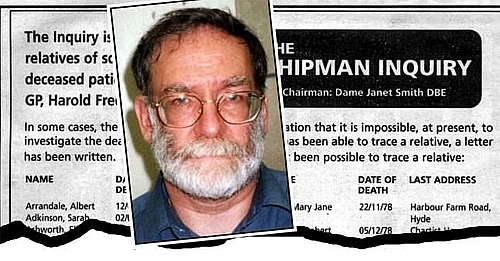 |
| Harold Shipman - DR Death |
Crimes
The local undertaker noticed that Dr. Shipman's patients seemed to be dying at an unusually high rate, and exhibited similar poses in death.
A covert investigation followed, but Shipman was cleared, as it appeared that his records were in order. The inquiry failed to contact the General Medical Council, or check criminal records, which would have yielded evidence of Shipman's previous record. Later, a more thorough investigation revealed that Shipman altered the medical records of his patients to corroborate their causes of death.
Hiding behind his status as a caring, family doctor, it is almost impossible to establish exactly when Shipman began killing his patients, or indeed exactly how many died at his hands, and his denial of all charges did nothing to assist the authorities.
Trial and imprisonment
Following extensive investigations, which included numerous exhumations and autopsies, the police charged Shipman with 15 individual counts of murder on September 7, 1998, as well as one count of forgery.
Shipman's trial commenced in Preston Crown Court on October 5, 1999. Attempts by his defense council to have Shipman tried in three separate phases, i.e. cases with physical evidence, cases without and the Grundy case (where the forgery differentiated it from other cases), as well as to have damning evidence relating to Shipman's fraudulent accumulation of morphine and other drugs, were thrown out, and the trial proceeded on the 16 charges included in the indictment.
On January 31, 2000, after six days of deliberation, the jury found Shipman guilty of killing 15 patients by lethal injections of diamorphine, and forging the will of Kathleen Grundy. The trial judge sentenced him to 15 consecutive life sentences and recommended that he never be released. Shipman also received four years for forging the will. Two years later, Home Secretary David Blunkett confirmed the judge's recommendation that Shipman never be released, just months before British government ministers lost their power to set minimum terms for prisoners.
On February 11, 2000, ten days after his conviction, the General Medical Council formally struck Shipman off its register.
Shipman consistently denied his guilt, disputing the scientific evidence against him. He never made any statements about his actions. His defence tried, but failed, to have the count of murder of Mrs Grundy, where a clear motive was alleged, tried separately from the others, where no obvious motive was apparent. His wife Primrose apparently was in denial about his crimes as well.
Although many other cases could have been brought to court, the authorities concluded it would be hard to have a fair trial, in view of the enormous publicity surrounding the original trial. Also, given the sentences from the first trial, a further trial was unnecessary. The Shipman Inquiry concluded Shipman was probably responsible for about 250 deaths. The Shipman Inquiry also suggested that he liked to use drugs recreationally.
Death
Harold Shipman committed suicide by hanging in his cell at Wakefield Prison at 06:20 on January 13, 2004, on the eve of his 58th birthday, and was pronounced dead at 08:10. A Prison Service statement indicated that Shipman had hanged himself from the window bars of his cell using bed sheets.
Some of the victims' families said they felt cheated, as his suicide meant they would never have the satisfaction of Shipman's confession, and answers as to why he committed his crimes.
Aftermath
In January 2001, Chris Gregg, a senior West Yorkshire detective was selected to lead an investigation into 22 of the West Yorkshire deaths. Following this, a report into Shipman's activities submitted in July 2002 concluded that he had killed at least 215 of his patients between 1975 and 1998, during which time he practiced in Todmorden, West Yorkshire (1974–1975) and Hyde, Greater Manchester (1977–1998). Dame Janet Smith, the judge who submitted the report, admitted that many more suspicious deaths could not be definitively ascribed to him. Most of his victims were elderly women in good health.
In her sixth and final report, issued on 24 January 2005, Smith reported that she believed that Shipman had killed three patients, and she had serious suspicions about four further deaths, including that of a four-year-old girl, during the early stage of his medical career at Pontefract General Hospital, West Riding, Yorkshire. Smith concluded the probable number of Shipman's victims between 1971 and 1998 was 250. In total, 459 people died while under his care, but it is uncertain how many of those were Shipman's victims, as he was often the only doctor to certify a death.
In 2005, it came to light that Shipman might have stolen jewellery from his victims. Over £10,000 worth of jewellery had been found in his garage in 1998, and in March 2005, with Primrose Shipman pressing for it to be returned to her, police wrote to the families of Shipman's victims asking them to identify the jewellery.
Unidentified items were handed to the Assets Recovery Agency in May. In August the investigation ended: 66 pieces were returned to Primrose Shipman and 33 pieces were auctioned. The proceeds of the auction went to Tameside Victim Support. The only piece actually returned to a murdered patient's family was a platinum-diamond ring, for which the family were able to provide a photograph as proof of ownership.
| Shipman, a television dramatisation of the case, was made in 2002 and starred James Bolam in the title role. The case was also referenced in an episode of the 2003 television series Diagnosis: Unknown called "Deadly Medicine" (Season 2, Episode 17, 2003). Shipman's activities also inspired D.A.W., an episode of the American TV series Law & Order: Criminal Intent. In it, the police investigate a physician who they discover has killed 200 of his patients. Both The Fall and Jonathan King have released songs about Shipman. The Fall's song is, "What About Us?", from the 2005 album Fall Heads Roll. King's song became controversial when, six months after its release, it was reported to be in Shipman's defence, urging listeners not to "fall for a media demon". As of early 2009, families of the victims of Shipman are still seeking compensation for the loss of their loved ones. In September 2009, it was announced that letters written by Shipman during his prison sentence were to be sold at auction. Following complaints from victims' relatives and the media, the letters were removed from sale. |
10. HERMAN MUDGEAMERICAN SERIAL KILLER
Who is Herman Mudgett - Biography
Herman Webster Mudgett (May 16, 1861 – May 7, 1896), better known under the alias of "Dr. H. H. Holmes," was an American serial killer.
Holmes trapped, tortured, and murdered possibly hundreds of guests at his Chicago hotel, which he opened for the 1893 World's Fair.
The case was notorious in its time, and received wide publicity via a series of articles in William Randolph Hearst's newspapers. Interest in Holmes' crimes was revived in 2003 by the publication of a best-selling book about him, The Devil in the White City.
Although Holmes is sometimes referred to as America's first serial killer, his crimes occurred after those of others such as Thomas Neill Cream, the Austin Axe Murderer and the Bloody Benders.
Herman Mudgett Erly Life, Family
He was born in Gilmanton, New Hampshire, son of Levi Horton Mudgett and his wife, formerly Theodate Page Price.
His early criminal career was based on fraud and forgery, including a cure for alcoholism, real estate scams, and a machine that purported to make natural gas from water. Holmes earned a doctor's degree from the University of Michigan.
On 8 July 1878, he married Clara A. Lovering of Alton, New Hampshire. On 28 January 1887, he (bigamously) married Myrta Z. Belknap in Minneapolis, Minnesota; they had a daughter named Lucy. He filed a petition for divorce from his first wife after marrying his second, but it never became final. He married his third wife, Georgiana Yoke, on 9 January 1894. He was also the lover of Julia Smythe, the wife of Ned Connor, one of his trusted associates. She later become one of his victims.
Career & Crimes
He managed to secure a Chicago pharmacy by defrauding the pharmacist, and built a block-long, three-story building on the lot across the street. He called this building "The Castle," and opened it as a hotel for the World's Columbian Exposition in 1893. The bottom floor of the Castle contained shops, the top his personal office, and the middle floor a maze of over one hundred windowless rooms.
Over a period of three years, Holmes selected female victims from among his hotel's guests, and tortured them in soundproof and escapeproof chambers fitted with gas lines that permitted Mudgett to asphyxiate the women at any time. Holmes had repeatedly changed builders, to ensure that no one truly understood the design of the house he had created who might report it to the police. Once dead, the victims' bodies went by chute to the basement, where they were either sold to medical schools or cremated and placed in lime pits for destruction.
Following the World's Fair, Holmes left Chicago and apparently murdered people as he traveled around the country. He was arrested in 1895 when he was discovered with the body of a former business associate, Benjamin Pitezel, and three of his children.
The same year, Holmes's "castle" in Chicago burnt down on August 19, revealing the carnage therein to the police and firemen. His habit of taking out insurance policies on some of his victims before killing them may have eventually exposed him regardless. The number of Holmes' victims has typically been estimated between 20 to 100, and even as high as 200. These victims were primarily women, but included some men and children.
Trial and Death
Holmes was put on trial for murder, and confessed to 27 murders (in Chicago, Indianapolis and Toronto) and six attempted murders.
He was hanged on May 7, 1896, in Philadelphia. It was reported that when the executioner had finished all the preliminaries of the hanging, he asked, "Ready, Dr. Holmes?", to which Holmes said, "Yes. Don't bungle." The executioner did "bungle," however, because Holmes' neck did not snap immediately; he instead died slowly and painfully of strangulation over the course of about 15 minutes.
 |
| Herman Webster Mudgett - an American serial killer |
Herman Mudgett Quick FactsKill: Around 200 Born: May 15, 1861 in Gilmanton, New Hampshire, USA Died: May 7, 1896 in Philadelphia, Pennsylvania, USA Nationality: American Profession: Businessman & insurance fraudster Span of killings: unknown start – 1894 Location of killings: Mostly in Chicago, USA, some in several other places in the USA and also in Toronto, Canada Modus operandi: Killed men, women, children at random, including friends and family members, and made their bodies disappear afterwards. In Chicago, he bought a two-story building which he turned into his “murder castle” and lured his victims there. Arrest and Punishment: Arrested in 1894 and hanged to death two years later |
11. DANIEL CAMARGO - THE MANGROVE MOSTER
Daniel Camargo - Quick FactsClassification: Serial killer Characteristics: Rape Number of victims: 72 + Date of murders: 1974 / 1984 - 1986 Date of arrest: February 26, 1986 Date of birth: January 22, 1930 Victims profile: Young girls Method of murder: Strangulation - Stabbing with knife Location: Colombia / Ecuador Status: Sentenced to 16 years in prison in 1989, the maximum sentence available in Ecuador. Killed in prison by another prisoner on November 13, 1994 |
Who is Daniel Camargo - Biography
Daniel Camargo Barbosa was a psychopathic serial killer from Colombia, South America. It is believed that he raped and killed over 150 young girls in Colombia and Ecuador during the 1970s and 1980s.
Daniel Camargo Early Life, Family, Career
Camargo was born into a wealthy family living in Anolaima, a small town in the Colombian Andes, on January 22, 1930. His father was a local businessman named Daniel Camargo Briceño, and his mother, Teresa Barbosa, was his father's second wife. C
Camargo also had an older half-sister, born from his father's first marriage. When Camargo was two years old, his mother died and his father remarried to another woman shortly afterward. Camargo was very intelligent and did well in school (he would later be attributed to an IQ of 116). However, whenever he tried to reach out to Briceño, regardless of the subject, he would cut him short and tell Camargo that he was useless and a lost cause. Eventually, Camargo lost any interest in interacting with his father, and he perfected his newfound ability to lie and manipulate people, using it as a means to get out of having conversations with him.
| Camargo's mother died when he was a little boy and his father was overbearing and emotionally distant. He was raised by an abusive stepmother, who punished him and sometimes dressed him in girls clothing, making him a victim of ridicule in front of his peers. |
Since Briceño was emotionally distant and much more interested in his business than his family, Camargo's childhood was mostly influenced by his stepmother, Dioselina Fernández. Fernández was just an adolescent at the time of her marriage and she was obsessed with the idea of having a daughter of her own, which only became more pronounced when she found that she was unable to bear children. She doted on her stepdaughter while abusing her stepson, who she would punish by forcefully undressing him from the waist down and hitting him in the bare buttocks with a bullwhip. After Camargo developed violent tendencies and got in a fight at school, Fernández punished him by taking away his pants, forcing him to wear women's clothes, and inviting his schoolmates to come over and watch him. This abuse destroyed any popularity he had at school and made him a frequent victim of bullying. From then on, Camargo came to despise women and everything feminine.
In the early 1940s, Briceño sent him to a prestigious, all-male Catholic boarding school in Bogota. Camargo excelled academically again, but his plans to continue studying were truncated when his whole family was hit by economic hardship. Camargo was forced to drop out and get a job as a door-to-door salesman to support them and found that it was easy to convince people in the capital to let him into their homes or make purchases. In 1957, he started a relationship with a young client, Alcira Castillo, and convinced her to rent a house together after a few dates. However, the expenses turned out to be greater than he expected, and he tried to make ends meet by robbing a shop owned by another client on May 24, 1958. He was arrested a few hours later and sent to a minimum-security prison for petty theft. Taking advantage of a distraction, Camargo took a clipboard from a desk and pretended to be busy as he walked out with departing officers at the end of their shift. He returned home and resumed his life as if nothing had happened. In 1962, Camargo met another woman, Esperanza, and he fell in love with her to the point of deciding to leave Castillo, even though they had two children. After becoming engaged to Esperanza, he found that she wasn't a virgin like he assumed, and later found her in their bed with another man.
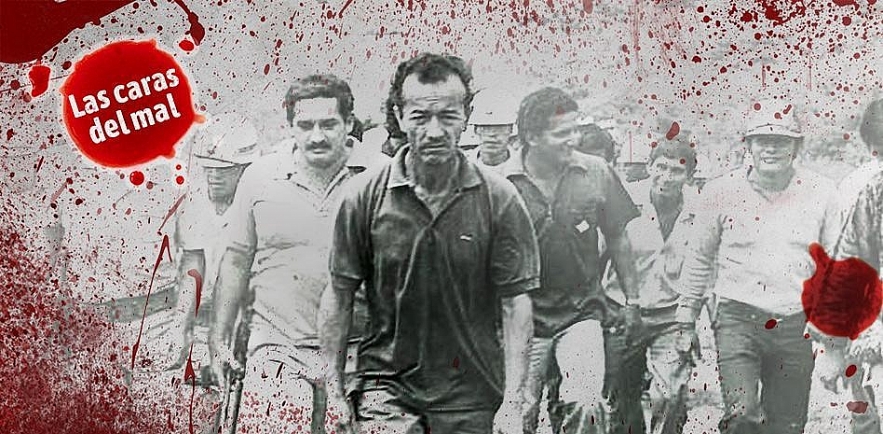 |
| Daniel Camargo Barbosa - "The Mangrove Monster" |
Crimes, Arrest, and Death
Camargo wanted to end the engagement at first, but found himself unable to do so. Using his skills at manipulation, he convinced her that she disappointed him and that she should make it up to him by providing virgin girls to him, so he could take their virginity in her place. Agreeing, Esperanza lured five young girls to their apartment and drugged them with barbiturates so Camargo could rape them while they were unconscious. This lasted until 1964, when their fifth victim realized what happened and identified them to police. The couple was arrested, and Camargo was initially sentenced to three years in prison. However, this was increased to eight years by another judge. Camargo considered himself a victim and resolved that when he raped a girl the next time, he would also murder her. After serving out his full sentence, he was released and moved to Brazil, but he was arrested for illegal immigration in 1973 and was deported to Colombia. In Colombia, Camargo began to work as a street vendor, selling television monitors.
On May 2, 1974, Camargo was walking in front of a school in Barranquilla when he saw a nine-year-old girl, who he found attractive. He lured her to a secluded area, raped her, and strangled her, leaving the body in the place along with the TV sets that he was transporting. The next day, Camargo returned to dispose of the body and retrieve the sets, but he was followed by a police officer who suspected him and he was arrested. He was convicted and sentenced to thirty years of seclusion in Gorgona, an island situated 35 kilometers off Colombia's Pacific coast. Ten years into his sentence, Camargo happened upon a rowboat in a beach. He immediately jumped in and didn't stop paddling until he reached the mainland, hours later. The prison reported him as a fugitive, but the authorities assumed he died at sea, since they believed that the currents were too treacherous to navigate through without experience. The press even ran stories about how Camargo had been eaten by sharks. In truth, Camargo spent the preceding years studying the sea currents, reading books about navigation and learning to orientate himself with precision. As soon as he landed, he ran south towards the Ecuadorian border. Camargo was the first prisoner to ever escape what had been dubbed "the Colombian version of Alcatraz."
Camargo first traveled to the capital of Quito, in the Andes, but during the cold night of December 5-6, 1984, on the open, he decided to move back to the coast. Days later, on December 18, Camargo abducted another nine-year-old girl in Quevedo, Ecuador, and killed her. He went on to commit at least 55 rapes and murders of both young girls and adult women between 1984 and 1986. Most of the murders happened in the Guayas province, but sometimes also in locations as far away as Quito, Machala, and Ambato (where another Colombian nomadic serial killer, Pedro López, had been active years earlier).
During this period, Camargo survived by working as a porter in the markets of Guayaquil, or selling clothing and objects taken from the victims. Just like in López's case, the authorities initially believed the murders were the work of organized crime, and many rumors pointed to white slavery rings, Satanic cults, or powerful people who were being protected by the authorities. The most accurate rumor was one claiming that a new serial killer, nicknamed "The Beast of the Andes", had decided to beat the record set earlier by López's number of victims.
| Interview In June 1986 Francisco Febres Cordero, a journalist for Hoy (Today) Newspaper, managed to arrange an interview with Camargo. It was difficult to get the interview due to the Police blocking all access to Camargo, and the fact that Camargo himself demanded a large fee before he would let himself be interviewed. The journalist pretended to be part of a group of psychologists that were allowed access to the prisoner, allowing him to ask Camargo questions without arousing his suspicion. Afterward Francisco Febres Cordero described him as highly intelligent, "He had an answer for everything and was able to speak of God and the Devil equally". Well-read, he cited Hesse, Vargas Llosa, García Márquez, Guimarães Rosa, Nietzsche, Stendhal and Freud, all knowledge that he acquired from a literary education during his time in prison on the Isle of Gargona. |
Arrest and Prison
Camargo was arrested on February 26, 1986, by two Quito policemen after he was found in possession of bloody clothes stolen from his last victim, Elizabeth Telpes. Incidentally, the suitcase where he was transporting the clothes also contained a copy of Fyodor Dostoyevsky's Crime and Punishment, which he had acquired while incarcerated in Gorgona.
Camargo was taken into custody and moved to Guayaquil after a local woman named María Alexandra Vélez announced that she survived an attack by a man matching his description. Camargo admitted to killing 71 victims in Ecuador following his escape from prison.
In 1989, he was convicted and sentenced to sixteen years, the maximum sentence available for murder in Ecuador. He was imprisoned at Quito's García Moreno Prison, coincidentally the same penitentiary housing López.
Death
On November 13, 1994, Camargo was sitting in his cell when a new inmate, 29-year-old Giovanny Arcesio Noguera Jaramillo, entered and forced him on his knees. After saying "It is the hour of vengeance", Noguera shanked Camargo eight times, killing him, and cut off one of his ears as a trophy. Noguera showed the ear to the guards, claiming his aunt was one of Camargo's victims and that he avenged her. Because nobody claimed Camargo's body, he was buried in a mass grave located in Quito's El Batán cemetery. He was 64 years old when he died.
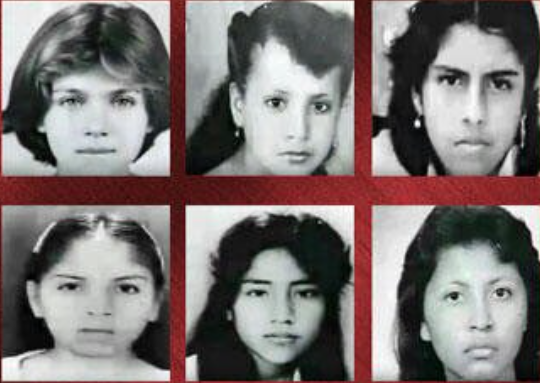 |
| Daniel Camargo's Victims |
Modus OperandiCamargo targeted females, willing to go after girls aged as young as nine, as long as he found them attractive. His favorite type of target was peasants, maids, and students transitioning from primary school to college. He would approach them, pretending he was a foreigner who needed to find a Protestant pastor in a church located on the outskirts of town, to whom he needed to deliver a large sum of money. His lie was supported by Camargo's educated vocabulary and fluency in English and Portuguese. He would then offer a reward to the girls if they would show him the way to the church, such as a small part of the money, candy, or pens; the older victims were offered jobs at the church. Most of the locations where the actual murders took place were remote and forested, and required a previous bus trip. Once in the woods, Camargo would walk some distance from the victim and conceal himself among the vegetation, claiming that he was now familiar with the area and had remembered a shortcut to their destination. If the victim got suspicious and refused to follow him, Camargo would make no attempt to stop them, simply changing location to find a new victim. If his lure was successful, Camargo would threaten the victims with a blade and rape them in a secluded spot, before killing them in a variety of ways, such as strangulation, stabbing and hacking, slashing, or crushing with a machete. One adult woman who struck him in the head with a rock while he was raping her enraged him so much, that he decapitated her on the spot and threw the head away. Another victim was gutted, with her lungs, kidneys, and heart extracted. After killing his victims, Camargo would steal the clothes and any valuables on their bodies before leaving the bodies to be eaten by scavengers. He always carried a second shirt so he could change his bloody clothes, and whenever his hands got bloodied, he would wash the blood away by urinating on them. He memorized any details about the victims that he could remember, even trivial ones like scars, tattoos, and moles. Sometimes, he even got the phone numbers of their families and called them after a crime to taunt them. |
13. JACK THE RIPPER
In 1888, London’s Whitechapel district was gripped by reports of a vicious serial killer stalking the city streets. The unidentified madman lured prostitutes into darkened squares and side streets before slitting their throats and sadistically mutilating their bodies with a carving knife.
That summer and fall, five victims were found butchered in the downtrodden East End district, sparking a media frenzy and citywide manhunt. A number of letters were allegedly sent by the killer to the London Metropolitan Police Service (also known as Scotland Yard), taunting officers about his gruesome activities and speculating on murders to come.
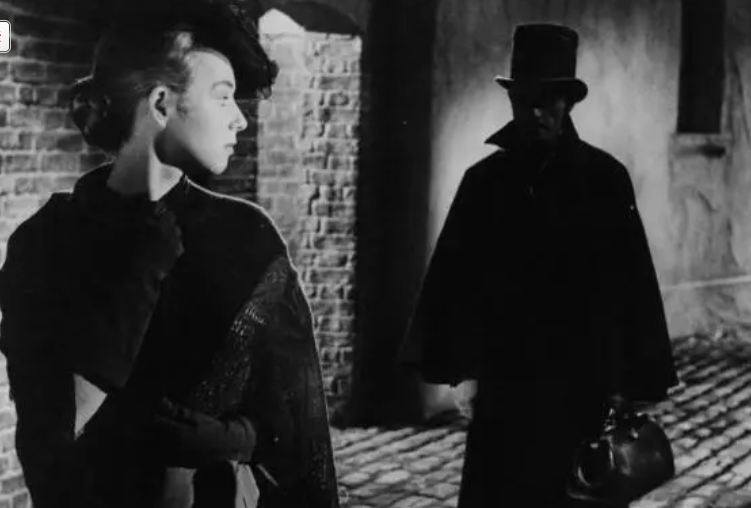 |
| A scene from the film ‘Jack The Ripper’, 1959. (Credit: Paramount/Getty Images) |
Without modern forensic techniques, Victorian police were at a loss in investigating the Ripper’s heinous crimes. After taking his final victim in November, the killer seemed to disappear like a ghost. The case was finally closed in 1892, but Jack the Ripper has remained an enduring source of fascination.
The most popular theories suggest that the killer’s understanding of anatomy and vivisection meant he was possibly a butcher or a surgeon. Over 100 possible suspects have been proposed.
Donald Henry Gaskins: The Hitchhikers' KillerGaskins has claimed to have killed between 80 to 90 people by torturing and mutilating them. He started killing in 1969, picking up hitchhikers on the coastal highways of the American South. A criminal associate witnessed him killing two young men and confessed to the police.
He was sentenced to death which was later turned to life imprisonment without any parole. Gaskins added another murder to his name and became the only man to have ever killed an inmate on death row. |
























